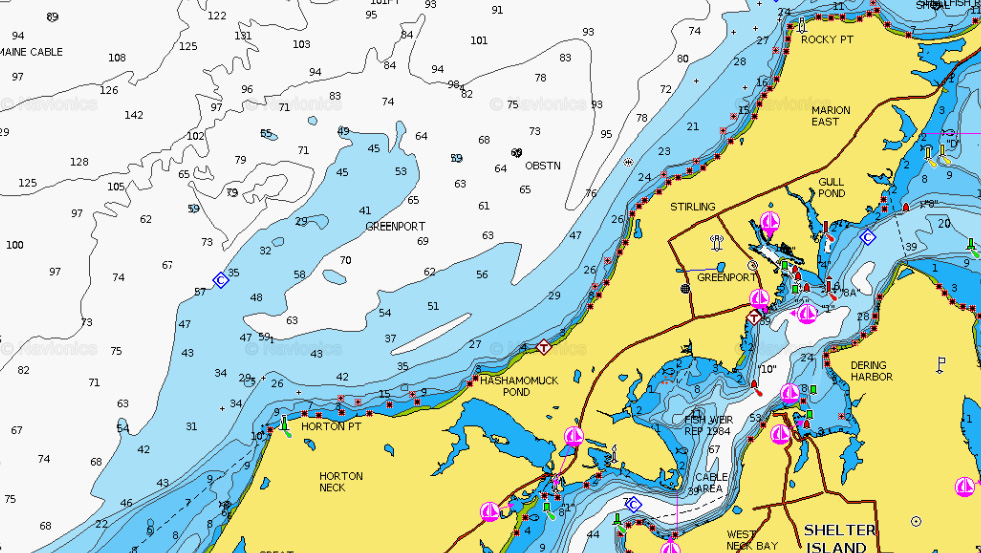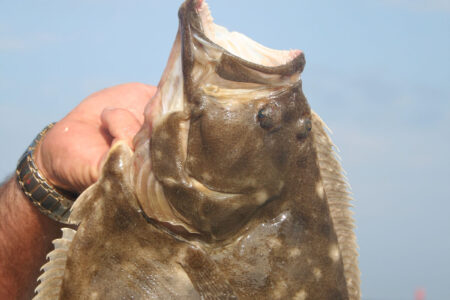
It wasn’t your typical October night when my buddy Paul Martinez and I decided to take a shot at some stripers east of Mattituck Inlet aboard Paul’s 25-foot Pursuit. The plan was to be at Hortons Point at slack tide around 8:30 p.m. and fish the first two or three hours of the ebb drifting live eels on 3×3 rigs across the rocky high spots (rip lines) just north of the Hortons Point Lighthouse. With air temperatures hovering in the mid-50s and the wind out of the southwest at 10 to 15 knots, we knew that the steam from Mattituck Inlet to Hortons Point was going to be relatively smooth. This was just fine by me in the event that Hortons drew a zonk and we’d be forced to employ our contingency plan, which was to work our way east to Rocky Point and repeat the tactics in hopes of finding some bass life. Thankfully Hortons decided to shine a bit of moonlight on us, as we traded off six 3×3 rigs that succumbed to Hortons merciless rock bottom and nine sea snakes for three nice bass apiece, which were all quickly released to fight another day. Whether you prefer bass fishing by day or by night, the fall of the year along the points and rips of the North Fork come to life as the stripers begin binge feeding for their annual migratory run, making them easy targets for anglers looking for a quality fish or two.
The eastern reaches of Long Island Sound are home to many boulder studded points created by terminal moraine glaciers. The placing of boulders on these points to prevent beach and land erosion by the Army Corps of Engineers over the years were helpful in creating productive fishing areas through the development of rips and eddies formed by currents sweeping over these structures. As beaches eroded, the boulders became submerged, creating ideal habitat for baitfish and the gamefish that feed on them. For the most part, these points become productive early in the season and then again in the fall. During the fall, once the waters begin to cool, and the bait moves out of the harbors and into the Sound, the bass go on the feed as they prepare for their migration back up the Hudson River or points south.

Chunk Time
Let’s take a look at a few tactics that will help you put bass in the boat starting with bunker chunking, a simple, time-proven method for catching stripers. Chunking may not be the most glamourous way of putting bass in the box, but it can be extremely effective and at times, the only way of getting the bass bite stimulated. In a nutshell, chunking involves anchoring up tide of a piece of bottom structure and drifting chunks back to where the fish are holding. Once you get a school of bass feeding on chunks behind the boat, the action can be nonstop. Chunking is effective wherever stripers gather over structure. The technique works in 10 feet of water all the way to down to 60 feet, as long as you can get the baits down to the fish. Try to reach your chosen chunking spot at slack tide or just as the water is starting to move. Drop anchor far enough ahead of the structure so that your baits reach bottom by the time the current carries them back to where the fish are likely to be holding. When you arrive, toss out a “test chunk” to gauge how fast it sinks in the current; this helps you position the boat. In some cases it’s a good idea to have a lot of anchor line when starting out, so that you can increase your distance from the structure as the current increases, thereby giving your baits more time to reach bottom. Conversely, as the current slows, you can shorten your anchor line to position the boat closer to the structure. Once you’re in position, toss out two or three chunks to establish a chum line and draw the fish in. Some anglers like to “sweeten” the chum line by lowering a chum pot filled with fish bits or clam bellies to the bottom. Try to minimize the freebies being doled out or you risk spoiling their appetite. Two or three small chunks per minute or so keeps the fish interested. If you get to an anticipated spot only to find some other boat beat you to the punch, don’t bother to set up nearby, as any fish in the area will likely already be lined up behind the other boat. You are better off trying a new location.
Rigging and Baiting Up
Rig up a 6- or 7-foot rod with a stiff butt and sensitive tip matched to a conventional reel that allows you to feed out line or to rest on the bottom without the bass feeling resistance when they pick up the bait. Braided line of 30- to 40-pound test is a good choice and will make it easier to feel pickups than if you were fishing mono. An 8-foot leader of 50- to 60-pound fluorocarbon is a good choice when fishing rocky areas where abrasion could easily cost you a good fish. If the bass are being fussy, try scaling down to a lighter leader. You can attach the leader to the main line with a swivel, although an Albright knot or a double surgeon’s knot allow you to reel the leader inside the rod tip when it’s time to land a fish. If bluefish are present, add a 1- or 2-foot length of flexible wire to the end of the leader to prevent lost rigs.
Speaking of rigs, the most common consists of a fish-finder above a barrel swivel and a 48-inch leader of 60-pound test fluorocarbon finished off with an 8/0 Gamakatsu circle hook. Sinkers round out the terminal end, with the lighter the lead the better. Depending on location and the stage of tide, anglers should only use enough lead to get the chunk down to the bottom. If you can get away with using no weight at all near slack water, your chances of hooking up increase dramatically. However, in deep water or when the current picks up steam, you’ll probably have no choice but to use some lead. In shallow areas you may be able to get away with a 1- or 2-ounce rubber core sinker attached midway up the leader. In deeper water, a sliding fish-finder sleeve can be slid on the main line before attaching the leader (In this case a swivel is required to keep the sinker from sliding down to the hook.). Bank sinkers of different weights can then be clipped to the sinker snap on the sleeve. Just remember to use the least amount of weight that’s necessary to hold bottom.
When it comes to bunker bait, the fresher the better. Chunks should be shiny, slimy and firm. You’ll generally need about 20 whole bunker to fish a four-hour stretch of tide with two rods. Once you have your baits, place them on ice or in an ice-brine solution to preserve their color and mucous coating. Also, be sure to cut up a 5-gallon bucket of chunks before you reach the fishing spot, so you’ll be ready to get down to business as soon as you arrive. Generally, the best times to chunk are the first and last two hours on either side of the tide change. Moving water is important, but too much current makes it difficult to get the bait down to the fish.
Three-Way Rig
Drifting 3-way rigs with live bait is another of several methods commonly employed along the North Shore for catching striped bass. It’s a simple rig consisting of a three-way swivel, and is effective in deep water, strong currents and roller coaster bottoms. To tie this rig, simply attach a 6- to 8-foot 60-pound leader snelled to a 5/0 to 7/0 circle hook at one end, and the other end to the center eye of the three-way with an improved clinch knot. On the lower end of the swivel, tie on an 18- to 24-inch leader of 40-pound monofilament for the sinker. The main line is tied to the remaining eye. Live baits such as eels, bunker, legal size porgies and spot can all be fished on a 3-way rig. The best way to hook any of the live baits is right through the snout or through both lips. With the exception of eels, those live baits mentioned are successfully fished during the daylight hours, while live eels work around the clock. They are however, most effective during the night tides.
To properly get the bait to the bass, drifts should begin up tide of a rip line. As you drift along, you will develop a feel for the rocky bottom and then be able to distinguish between the bottom and a pickup. At first, the thump of the rocks may seem like strikes from a fish. However, the strike from a striper is distinctively different. It may feel as if you’ve hooked onto a freight train, or it could be as subtle as a gentle thump. Either way, drive the hook home and hang on. Also, as you feel the sinker hit the rocks or the bottom, take one to three full turns on the reel. This will help keep snags to a minimum, but still expect to lose some gear. Make sure you bring plenty of extra terminal tackle as well as plenty of assorted size sinkers. In order to save time while fishing, it’s a good idea to tie several rigs before heading out.

Jig Time
Running into stripers on the surface during the fall migration is quite common and a dead giveaway when terns and gulls wheel overhead and dip down to pick up any scraps the bass may leave at the surface. Should the situation arise, diamond jigging becomes an effective approach that puts stripers in the box. Dropping the jig to the bottom and slowly retrieving it 5 or 6 feet off the bottom, then dropping back and repeating the process, is often the most effective and simple way to hook up with migrating bass. Stripers also hit the jig as it plummets toward the bottom so be prepared. Two- to 4-ounce hammered diamond jigs in both nickel and gold finishes get the nod for effectiveness during the fall migration, but don’t disregard smooth finished jigs or those with surgical tubes of assorted colors. There are times when the bass will only slam jigs with surgical tubes. Green, red, white and natural are the more common colors, and it’s always good to have an assortment. While some anglers prefer to tie their jigs directly to the main line, I suggest using a 6-foot double shock leader of 30-pound fluorocarbon using a Palomar knot at the jig and an Albright knot at the main line. Carrying a honing stone for touching up your hooks is strongly suggested. Sharper hooks penetrate better and catch more fish than dull hooks and greatly reduce the percentage of lost fish.
The potential for catching a cow bass off any of the eastern Sound points is made greater when all the elements of knowledge and tackle are blended together. As always, please practice self-restraint by staying in the limits of the law. Better yet, a fast photo and a quick release helps ensure the future of this fishery and gives you the satisfaction of watching the fish return to its watery world.




